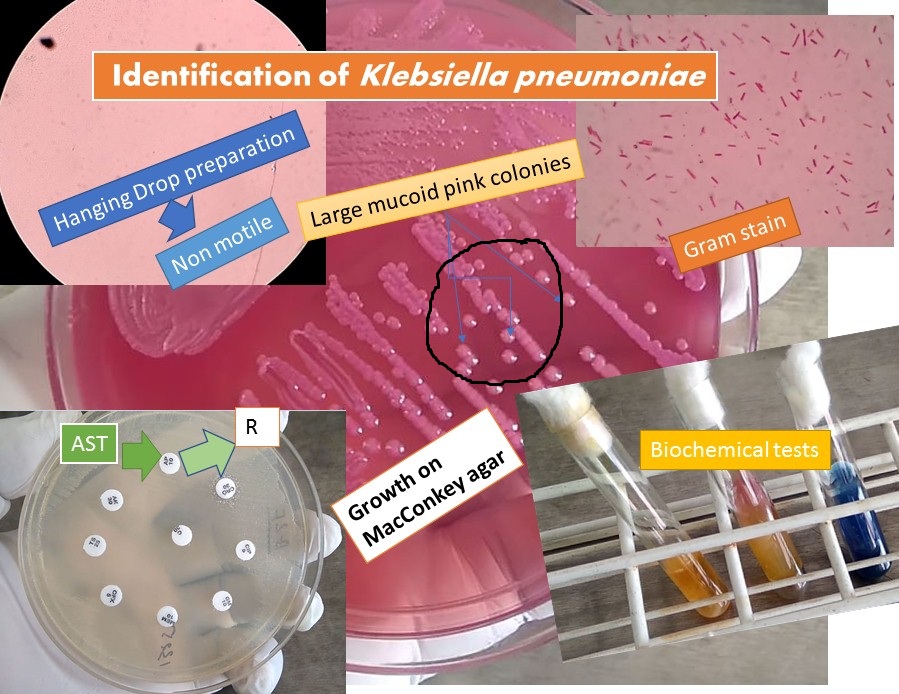Introduction of Klebsiella pneumoniae
Klebsiella pneumoniae scientific classification is as follows
- Domain: Bacteria
- Phylum: Proteobacteria
- Class: Gammaproteobacteria
- Order: Enterobacterales
- Family: Enterobacteriaceae
- Genus: Klebsiella
- Species: pneumoniae
- Subspecies of Klebsiella pneumoniae are-
- Klebsiella pneumoniae subspecies ozaenae
- Klebsiella pneumoniae subspecies pneumoniae
- Klebsiella pneumoniae subspecies rhinoscleromatis
Klebsiella is from the surname of German-Swiss microbiologist Edwin Klebs (1834–1913). Klebsiella is a genus of Gram-negative, oxidase-negative, fimbriated, non -motile, non-sporing rod-shaped bacteria with a prominent polysaccharide-based capsule and having size o,f 0.5 -0.8 µm wide to 1 -2 µm. They are found everywhere in nature and also in bacterial flora in our intestines.
Pathogenicity of Klebsiella pneumoniae
It may cause severe bronchopneumonia, urinary tract infections, nosocomial infections, wound infections, septicemia, meningitis, and rarely diarrhea too.
Isolation in laboratory
Klebsiella pneumoniae isolated from septicemic patient blood culture; on the basis of the following tests:-
Blood culture bottle incubated into Bactec.
After 23 hours of incubation, Bactec indicated positive.
The positive bottle was then sub-cultured into solid media Chocolate agar, blood agar, and MacConkey agar.
After overnight incubation, growth was seen in all three plates.
MacConkey’s agar
On MacConkey agar, the colonies appeared large, mucoid, and pink in color.
The mucoid nature of colonies is due to capsular material produced by the organisms.
Gram stain
Short thick Gram-negative rods
Motility by hanging drop preparation method
Non-motile
Biochemical tests
Catalase test -Positive
Oxidase -Negative
Nitrate reduction test- Reduced to nitrite
Acid/acid
No hydrogen sulfide (H2S) production
Production of gas
Motility Indole Urease (MIU) test
Non-motile because of only strict growth around the stab line
Urea hydrolyzation test-Test should be positive but here found negative may be due to Klebsiella pneumoniae subspecies rhinoscleromatis.
Indole -Negative
Note: Klebsiella oxytoca is indole positive.
Citrate Utilization Test
Positive
Fermentation of sugars (glucose, lactose and mannitol )- acid and gas
Methyl red test-Negative
Lysine decarboxylase test-Positive
Antibiotic sensitivity test
The antibiotic sensitivity test is also suggestive for Klebsiella pneumoniae because of ampicillin resistance which is intrinsically resistant.
Treatment
Clinical isolates of Klebsiella pneumoniae are resistant to a wide range of antimicrobial agents like ampicillin, Amoxycillin, and carbenicillin. This resistance is due to the R plasmid present in these organisms. Organisms are usually sensitive to cephalosporins, trimethoprim, nitrofurantoin, amoxicillin-clavulanic acid, and aminoglycosides. However, plasmid-mediated resistance to gentamycin and various cephalosporins has been reported in hospital strains.
#Related Videos
Klebsiella pneumoniae -introduction, pathogenesis, lab diagnosis and treatment
#K. pneumoniae growth on NA, BAP & MAC and its biochemical test-
#K. pneumoniae glucose utilization test using Andrade’s indicator-
# K. pneumoniae under Microscope ||K. pneumoniae Gram Stain
#K. pneumoniae growth on MacConkey agar, blood agar, and chocolate agar-
#Staphylococcus aureus, E. coli, and K. pneumoniae on growth on various media
Further Readings
- Bailey & Scott’s Diagnostic Microbiology. Editors: Bettey A. Forbes, Daniel F. Sahm & Alice S. Weissfeld, 12th ed 2007, Publisher Elsevier.
- Clinical Microbiology Procedure Handbook Vol. I & II, Chief in editor H.D. Isenberg, Albert Einstein College of Medicine, New York, Publisher ASM (American Society for Microbiology), Washington DC.
- Colour Atlas and Textbook of Diagnostic Microbiology. Editors: Koneman E.W., Allen D.D., Dowell V.R. Jr, and Sommers H.M.
- Cowan & Steel’s Manual for identification of Medical Bacteria. Editors: G.I. Barron & R.K. Felthani, 3rd ed 1993, Publisher Cambridge University Press.
- Jawetz, Melnick and Adelberg’s Medical Microbiology. Editors: Geo. F. Brook, Janet S. Butel & Stephen A. Morse, 21st ed 1998, Publisher Appleton & Lance, Co Stamford Connecticut.
- Mackie and Mc Cartney Practical Medical Microbiology. Editors: J.G. Colle, A.G. Fraser, B.P. Marmion, A. Simmous, 4th ed, Publisher Churchill Living Stone, New York, Melborne, Sans Franscisco 1996.
- Manual of Clinical Microbiology. Editors: P.R. Murray, E. J. Baron, M. A. Pfaller, F. C. Tenover and R. H. Yolken, 7th ed 2005, Publisher ASM, USA
- Textbook of Diagnostic Microbiology. Editors: Connie R. Mahon, Donald G. Lehman & George Manuselis, 3rd edition2007, Publisher Elsevier.
- Topley & Wilsons Principle of Bacteriology Vol I, Editors: M.T. Parker & L.H. Collier, 8th ed 1990, Publisher Edward Arnold publication, London.
- District Laboratory Practice in Tropical Countries – Part-2- Monica Cheesebrough- 2nd Edn Update
